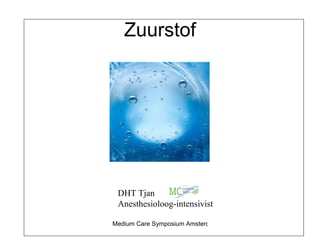
Sessie 2: Alles draait om zuurstof
- 1. Zuurstof DHT Tjan Anesthesioloog-intensivist
- 5. 1. Ventilatie 2. Circulatie 3. Weefselcirculatie O 2 cascade
- 6. Ventilatie O 2 opname in alveoli O 2 transport O 2 uitwisseling op celniveau CO 2 uitwisseling CO 2 transport CO 2 afgifte in alveoli Ventilatie Circulatie microcirculatie
- 7. Gaswisseling: O 2 Figure 18-3a: Gas exchange at the alveoli and cells PO 2 gradiënt 13,3 Kpa 5,3 Kpa
- 8. Gaswisseling: CO 2 Uitwas CO 2 5,3 Kpa 6,1 Kpa
- 9. Respiratoire aandoeningen atmosfeer luchtwegen longen interstitieel circulatie O 2
- 11. Hemoglobine
- 15. Oxyhemoglobin equilibrium (dissociation) curve of hemoglobin.1 The normal P50 value is indicated by the dashed lines. ©2005 by American College of Chest Physicians
- 18. CaO 2 in bloed: O 2 PLAY Hb = 0 Normaal Verminderde PaO 2
- 20. Relative effects of changes in Pao2, hemoglobin, and CO on Do2 in a critically ill patient. ©2005 by American College of Chest Physicians
- 25. Relationship between oxygen delivery and consumption.
- 30. Zuurstof transport van atmosfeer naar mitochondria
- 31. Locale capillaire O2 spanning and diffusie gradient en afstand
- 35. Microcirculatie
- 36. Influence of intercapillary distance on the effects of hypoxia, anaemia, and low flow on the oxygen delivery-consumption relationship.
- 39. Oxygen Debt: To Pay or Not to Pay O 2 schuld Herstel mogelijk Vertraagd herstel: celschade Ernstige ischemie: celnecrose Tijd O 2 gebruik Lactaatvorming
- 44. Alarmsignalen bij vitaal bedreigde patiënt score ZGV A= alert, V= reactie op aanspreken, P=reactie op pijn stimulus, U= geen reactie Bij meer dan 5 l O2 : 2 punt extra Bij meer dan 10l O2: 3 punt extra Wanneer de urineproductie < 50cc gedurende afgelopen 3 uur 2 punten extra bij preëxistent normale nierfunctie. Bij 8 punten of meer waarschuw de verantwoordelijke achterwacht en overweeg of er IC ondersteuning moet worden overwogen. score 3 2 1 0 1 2 3 4 HR <40 40-50 51-100 101-110 111-130 >130 >150 BP syst <70 70-80 81-100 101-200 >200 AF <8 9-16 17-20 21-30 >30 T <35 35-36.5 36.6-37.5 37.6-39 >39 Bewustzijn A V P U SaO2 >94 90-94 88-90 <88 lactaat <1.1 1.2-2 2.1-3 3.1-4 >4
- 52. Outreach alarmscore cards and ballpen
- 54. Patient A
- 58. Normale SvO 2 40-60 % 70–80 %
- 59. Oorzaak hoge SvO 2 (85%) hartfalen sepsis
- 60. Oorzaak lage SvO 2 (45%) anemie hypoxie
- 61. Hartfalen beinvloedt SvO 2 ?
- 62. DO 2 wordt vooral door o.a.? PaO 2 SaO 2
- 63. CO is belangrijk voor O2 aanbod ? JA NEE
- 65. Vragen ?
Notas del editor
- Oxyhemoglobin equilibrium (dissociation) curve of hemoglobin.1 The normal P50 value is indicated by the dashed lines. The changes in position of the curve associated with various effector molecules are indicated by the dashed arrows. DPG = diglycerophosphate; P50 = oxygen tension at which hemoglobin is 50% saturated; CO = carbon monoxide. Used with permission from Piantadosi and Huang.1
- Relative effects of changes in Pao2, hemoglobin, and CO on Do2 in a critically ill patient. Do2 in a normal 75-kg subject at rest is shown in the white bar, and Do2 in a patient with hypoxemia, anemia, and reduced CO is shown in the black bar. The gray bars show the effect of sequential interventions on Do2. The numbers in each bar represent the calculated increase in Do2 compared with the preceding value. Fio2 = fraction of inspired oxygen; Hb = hemoglobin; CO = cardiac output. Data are from Leach and Treacher.2
- Relationship between oxygen delivery and consumption.
- Oxygen transport from atmosphere to mitochondria. Values in parentheses for a normal 75 kg individual (BSA 1.7 m2) breathing air (Fio2 0.21) at standard atmospheric pressure (PB 101 kPa). Partial pressures of O2 and CO2 (Po2, Pco2) in kPa; saturation in %; contents (Cao2, Cvo2) in ml/l; Hb in g/l; blood/gas flows (Qt, Vi/e) in l/min. P50 = position of oxygen haemoglobin dissociation curve; it is Po2 at which 50% of haemoglobin is saturated (normally 3.5 kPa). Do2 = oxygen delivery; Vo2 = oxygen consumption, Vco2 = carbon dioxide production; Pio2, Peo2 = inspired and mixed expired Po2; Peco2 = mixed expired Pco2; Pao2 = alveolar Po2.
- Diagram showing the importance of local capillary oxygen tension and diffusion distance in determining the rate of oxygen delivery and the intracellular Po2. On the left there is a low capillary Po2 and pressure gradient for oxygen diffusion with an increased diffusion distance resulting in low intracellular and mitochondrial Po2. On the right the higher Po2 pressure gradient and the shorter diffusion distance result in significantly higher intracellular Po2 values.
- Influence of intercapillary distance on the effects of hypoxia, anaemia, and low flow on the oxygen delivery-consumption relationship. With a normal intercapillary distance illustrated in the top panels the Do2/Vo2 relationship is the same for all interventions. However, in the lower panels an increased intercapillary distance, as would occur with tissue oedema, reducing Do2 by progressive falls in arterial oxygen tension results in a change in the Do2/Vo2 relationship with Vo2 falling at much higher levels of global Do2. This altered relationship is not seen when Do2 is reduced by anaemia or low blood flow.
